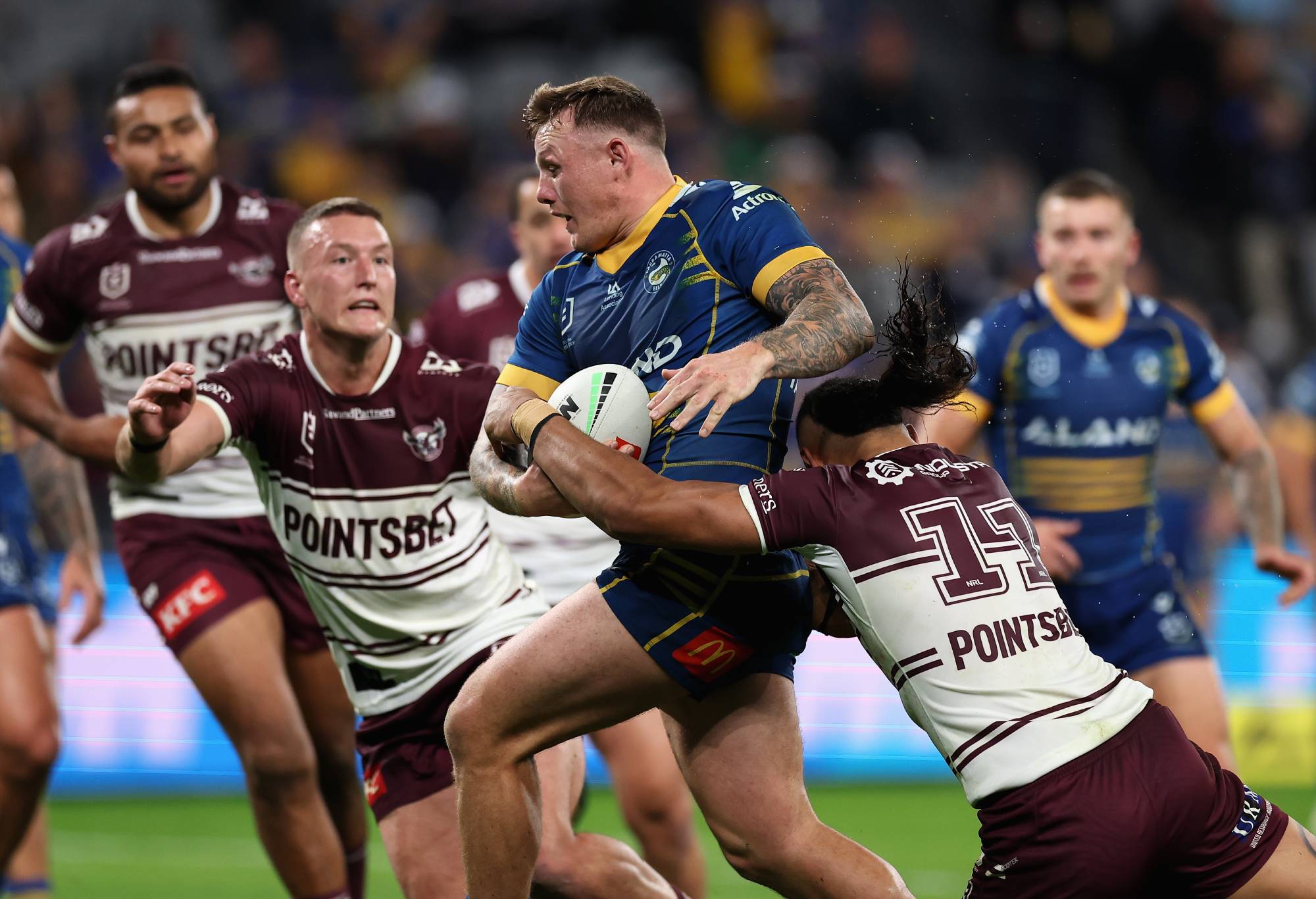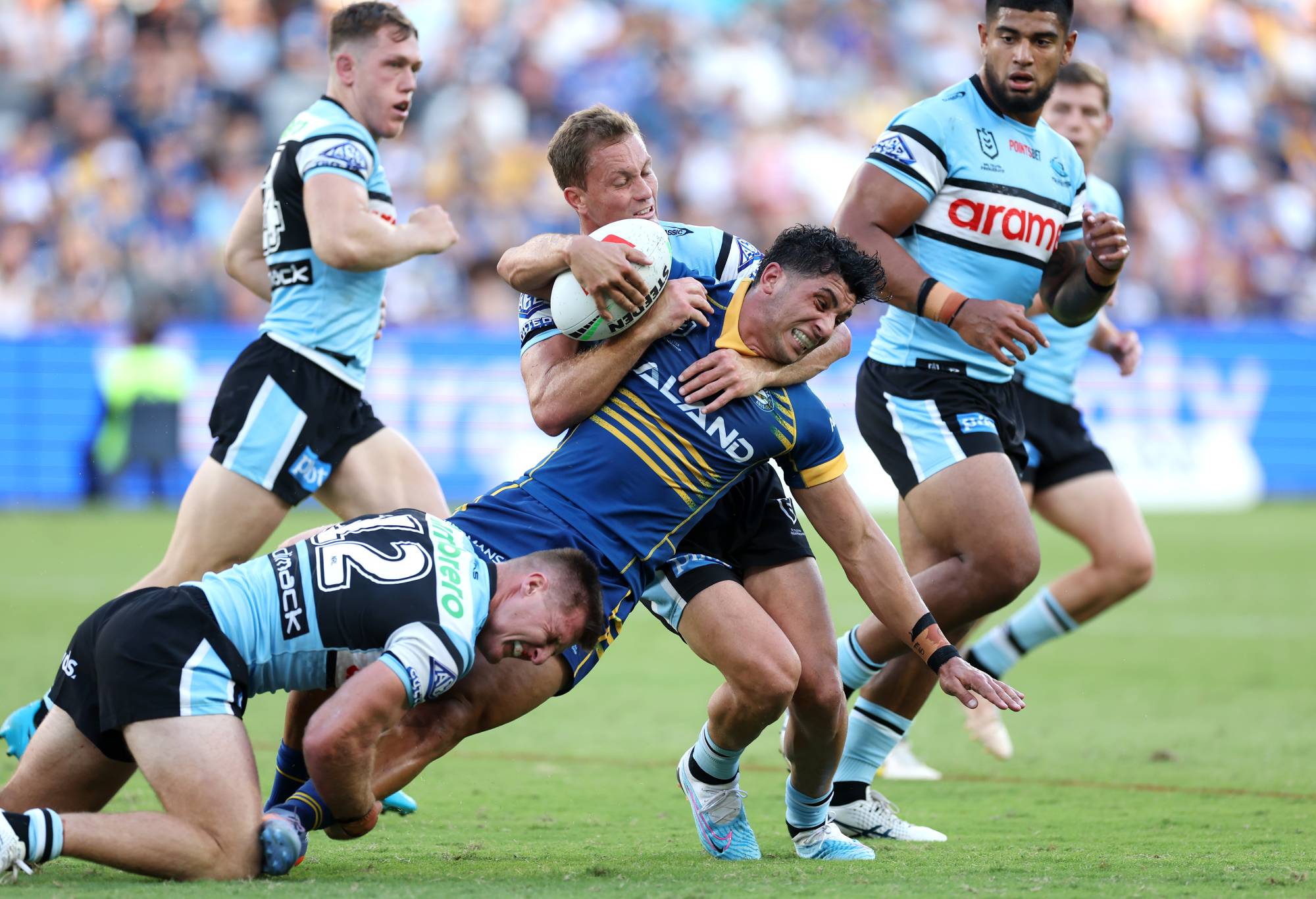When you’re Parramatta, everything can feel like a struggle.
They’re one of the great sporting clubs of the world when it comes to being associated with failure.
You could stick the Eels alongside their similarly-coloured, similarly unsuccessful Super League cousins Warrington, perennial non-winners St Kilda from the AFL and their fellow black and whites Newcastle United, plus a bevvy of drought-stricken US franchises from Toronto’s leafy losers to Arizona’s Cardinal sinners.
What all of those clubs have in common is not only that they haven’t won anything in ages, but also that their fans keep on coming back, which means the club continually has clout and prestige, which means they always have a few stars despite results.
That’s where Parra find themselves now. This is not a bad team, but it is a heavily imbalanced one.
Genuine superstars like Mitchell Moses and Dylan Brown in the halves, Clint Gutherson at the back and Reagan Campbell-Gillard and Junior Paulo in the middle play alongside guys with a level miles beneath theirs.
We could debate the merits of Brendan Hands and Joey Lussick, for example, for the dummy half role, or between Sean Russell and Haze Dunster for a wing spot, but the truth is that neither are really that good.
In 2023, coach Brad Arthur could be heartened by the emergence of J’maine Hopgood and and the renaissance of Bryce Cartwright, but it’s hard to see where 2024’s version of that comes from.
The new arrivals are Kelma Tuilagi and Morgan Harper, and when you’re adding to the squad with guys who a team that finished below you in the ladder were happy to let go, you’re probably not strengthening.
It’s not that either are bad players but they’re not world-beaters, and looking year-on-year, it’s hard to call this team better.
Arthur finds himself in a bit of a bind. Since the 2022 Grand Final, his side have certainly regressed.
They lost Reed Mahoney, unquestionably their best 9, and haven’t replaced him. They lost Isaiah Papali’i and saw much the same, albeit with the caveat that his partner in crime, Shaun Lane, was injured for a lot of 2023.
The coach, however, couldn’t really replace anyone without cutting one of his big names and will be pleased to have retained their best five players for the long term.
Where Parra are now, essentially, is where Manly were in 2022: they have a long-term, well-established coach and a coherent style of play, with some of the best players in the comp, but a salary cap that is heavily skewed to the top.

(Photo by Cameron Spencer/Getty Images)
As was the case with late-period Des Hasler Manly, they can beat anyone on their day and a lot of teams most days, but are but a few injuries and suspensions away from a major depth crisis.
One could argue that we already saw that last year. Of their 24 games, RCG got 14, Lane got ten and Brown 17, which is more salary cap sat in the grandstand than they could afford.
Looking across the whole season, there were only six games when all of their big five earners were available – Parra went 2-4 in them, albeit against tough opposition, and all were before Round 9. Thereafter, Arthur never had them available.
The light at the end of the tunnel will be that the injuries forced players in who can now strengthen the depth.
Wiremu Greig, previously untrusted by Arthur and often left picking splinters for 80 minutes, kicked on when given more time and, you’d hope, will be backed in further in 2024.
Joe Ofahengaue, who arrived from the Tigers and immediately got injured, was back by the end of the year and should be good to go.
Arthur’s style is so forward-dominant that it needs to have constant rotations to work. At least to start, he’ll have four guys he can call upon in the middle, plus Ryan Matterson somewhere filling in.
If the coach trusts those he played last year, he can begin 2024 with one of the very best packs going around, and then maintain the rage across 80 minutes through his interchanges, which have been the Achilles heel for over two years now.
If he can get Lane onto the field and keep Cartwright at the level he was at in 2023, then suddenly this is a team that will generate a lot of second phase, which brings his halves and fullback into the game even more.
What remains to be seen is how he gets the best out of his outside backs, because the downside of having such top end stars on the cap is that it means less heralded players elsewhere who have to be covered.
Russell and Bailey Simonsson stand as one of the poorest edges, and in a weak link sport like rugby league, that’s a problem.

(Photo by Mark Kolbe/Getty Images)
Last year, the stats told what is, by now, a pretty familiar story.
Parra won the middle in attack, but weren’t always able to capitalise on the forward dominance to score points, and then were a little too weak defensively in central areas to compete with the best.
The Eels were pretty much exactly where a team that finished ninth should be in key metrics like run metres and line breaks, but crucially, they’re not trying to finish ninth and have a roster that expects to be a lot better than that.
The outside backs tell this tale. Maika Sivo and Will Penisini were upper echelon creatively, the other two weren’t anywhere near it. In yardage, it’s much the same, and that’s just with the ball.
Penisini was horrendous defensively – not far off Valynce Te Whare in line break causes, among the absolute worst among centres. Russell and Simonsson were not much better.
There were 111 players who played enough in the OBs to make a simple sample size cutoff last year, and Parra had six of their players in the bottom third – Russell, Simonsson, Penisini, Dunster, Isaac Lumelume and Waqa Blake – and just signed a seventh in Harper. That’s really, really bad.
Is that a poor middle giving them too much to do? Is it bad defenders defending badly?
Arthur has to hope that a consistently better pack, with more settled players and a sensible allocation of minutes can stop the drain of metres and, ultimately, points.
Looking at the data, it suggests that their outside backs will concede line breaks regardless, but at least they can have a lot of space behind them to recover if those breaks happen further from their own line.
That has largely been what has kept Parra going. The kicking of Moses is long enough to move the game downfield and the average metres per set with the ball is second only to the Panthers, proving just how good the Eels can be when they get a roll on.
The issue is the other way. This will be the third season in a row where that has been the biggest weakness for Parramatta.
In 2022, they were so good that it didn’t actually matter that much. In 2023, it was perhaps not their fault, with injuries and suspensions hitting them harder than most.
This time around, however, everyone is on deck and they know what the problem is. Time to fix it.






























































































